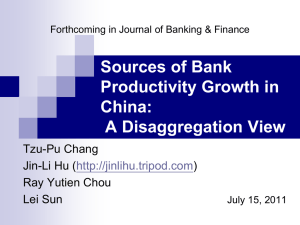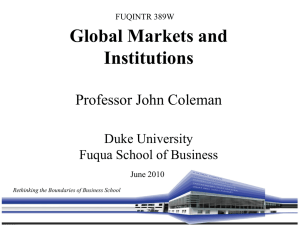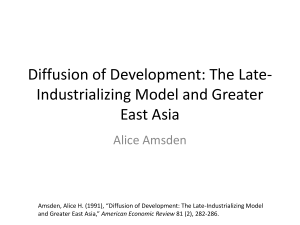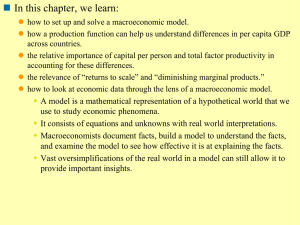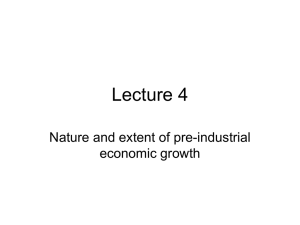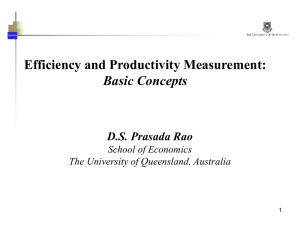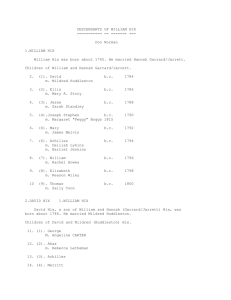Technical change - Agricultural & Applied Economics
advertisement
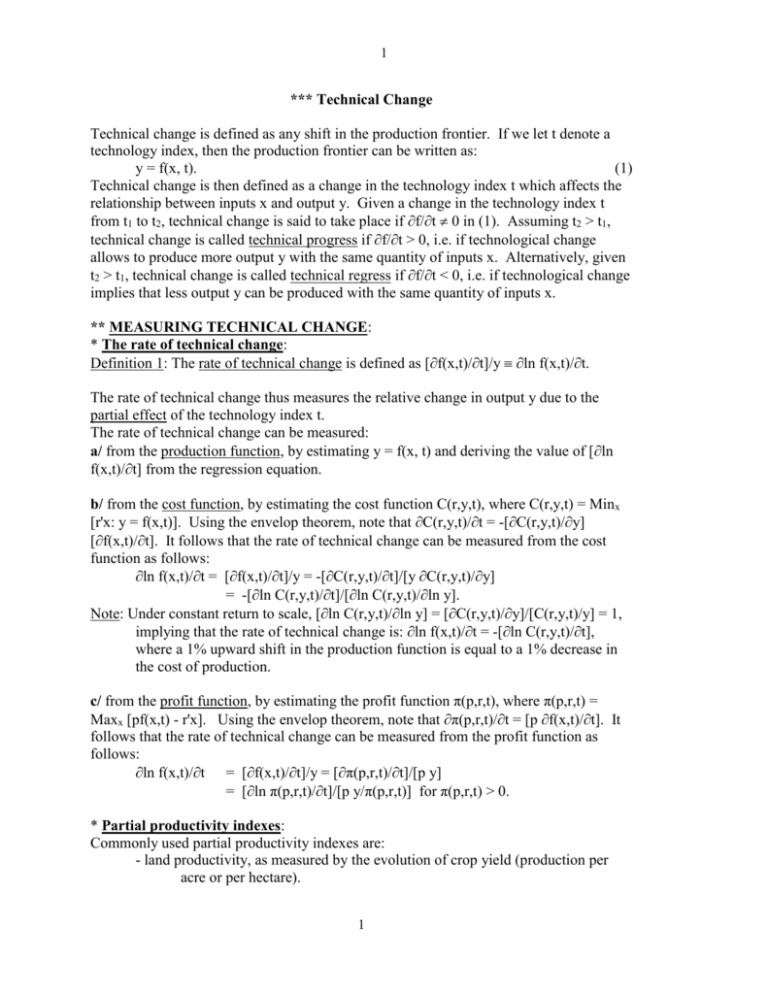
1
*** Technical Change
Technical change is defined as any shift in the production frontier. If we let t denote a
technology index, then the production frontier can be written as:
y = f(x, t).
(1)
Technical change is then defined as a change in the technology index t which affects the
relationship between inputs x and output y. Given a change in the technology index t
from t1 to t2, technical change is said to take place if f/t 0 in (1). Assuming t2 > t1,
technical change is called technical progress if f/t > 0, i.e. if technological change
allows to produce more output y with the same quantity of inputs x. Alternatively, given
t2 > t1, technical change is called technical regress if f/t < 0, i.e. if technological change
implies that less output y can be produced with the same quantity of inputs x.
** MEASURING TECHNICAL CHANGE:
* The rate of technical change:
Definition 1: The rate of technical change is defined as [f(x,t)/t]/y ln f(x,t)/t.
The rate of technical change thus measures the relative change in output y due to the
partial effect of the technology index t.
The rate of technical change can be measured:
a/ from the production function, by estimating y = f(x, t) and deriving the value of [ln
f(x,t)/t] from the regression equation.
b/ from the cost function, by estimating the cost function C(r,y,t), where C(r,y,t) = Minx
[r'x: y = f(x,t)]. Using the envelop theorem, note that C(r,y,t)/t = -[C(r,y,t)/y]
[f(x,t)/t]. It follows that the rate of technical change can be measured from the cost
function as follows:
ln f(x,t)/t = [f(x,t)/t]/y = -[C(r,y,t)/t]/[y C(r,y,t)/y]
= -[ln C(r,y,t)/t]/[ln C(r,y,t)/ln y].
Note: Under constant return to scale, [ln C(r,y,t)/ln y] = [C(r,y,t)/y]/[C(r,y,t)/y] = 1,
implying that the rate of technical change is: ln f(x,t)/t = -[ln C(r,y,t)/t],
where a 1% upward shift in the production function is equal to a 1% decrease in
the cost of production.
c/ from the profit function, by estimating the profit function π(p,r,t), where π(p,r,t) =
Maxx [pf(x,t) - r'x]. Using the envelop theorem, note that π(p,r,t)/t = [p f(x,t)/t]. It
follows that the rate of technical change can be measured from the profit function as
follows:
ln f(x,t)/t = [f(x,t)/t]/y = [π(p,r,t)/t]/[p y]
= [ln π(p,r,t)/t]/[p y/π(p,r,t)] for π(p,r,t) > 0.
* Partial productivity indexes:
Commonly used partial productivity indexes are:
- land productivity, as measured by the evolution of crop yield (production per
acre or per hectare).
1
2
- labor productivity, as measured by the evolution of production per worker or per
unit of labor time.
These productivity indexes are called "partial" productivity indexes because they focus
on the input-output relationship only one input at a time. They are relatively easy to
estimate. However, the fact that they do not control for all input use suggests that they
may not provide much information of the existence and nature of technical change. For
example, an increase in yield does not necessarily imply technological change. It may
simply be associated with an increase in the use of non-land inputs (e.g. fertilizer), i.e. a
move along a given production frontier.
* Total factor productivity indexes: (TFP indexes)
Let t denotes a time index in equation (1). Total differentiation of equation (1) with
respect to x and t gives
[d ln y] = i [ln f(x,t)/xi] d xi + [ln f(x,t)/t] d t.
(2)
It follows that the rate of technical change can be written as:
ln f(x,t)/t = [d ln y]/[d t] - i {[ln f(x,t)/xi] [d xi]/[d t]},
(3)
Equation (3) illustrates that the rate of technical change is the rate of output change that
cannot be explained by the change in inputs between the two periods. Note that this
implicitly treats technical change as a residual measure.
Denote by ri the input price for the i-th input. Under cost minimization, note that ln
f(x,t)/xi = [f(x,t)/xi]/y = ri/[y C(r,y)/y], where we used the first order condition for
cost minimization: f(x,t)/xi = ri/[C(r,y)/y], i = 1, 2, ..., n. It follows that, under cost
minimization, equation (3) becomes:
ln f(x,t)/t = [d ln y]/[d t] - i {[ri/(y C(r,y)/y)] [d xi]/[d t]},
= [d ln y]/[d t] - i {[ri xi/C(r,y)]/[ln C(r,t)/ln y] [d ln xi]/[d t]},(4)
where [ln C(r,t)/ln y] = [C(r,t)/y]/[C(r,t)/y] and [d ln xi] = [d xi]/xi. But, under
constant return to scale, [ln C(r,t)/ln y] = [C(r,t)/y]/[C(r,t)/y] = 1. Thus, under
constant return to scale, equation (4) takes the form:
ln f(x,t)/t = [d ln y]/[d t] - i {wi [d ln xi]/[d t]},
(5)
where wi = [ri xi/C(r,y)] denotes the i-th cost share, i = 1, 2, ..., n.
Now consider a change from t = 0 to t = 1. Denote by xit and yt the observed value taken
respectively by xi and y at time t, t = 0, 1. Then, we have the following discrete
approximations:
[d ln y]/[d t] = ln y1 - ln y0 = ln (y1/y0),
[d ln xi]/[d t] = ln xi1 - ln xi0 = ln (xi1/xi0), i = 1, 2, ..., n,
wi = ½[wi0 + wi1],
where wit = [rit xit]/[i rit xit] is the i-th input cost share at time t, i = 1, 2, ..., n, t = 0, 1.
Using these approximations, equation (5) becomes
ln f(x,t)/t = ln[y1/y0] - i {½[wi0+wi1] [ln (xi1/xi0)]}.
(6)
Equation (6) provides an empirically tractable measure of the rate of technical change
from t = 0 to t = 1.
2
3
Note that IO [y1/y0] can be interpreted as an output quantity index for the observation at
t = 1, using t = 0 as a base. Also, note that II exp[i {½[wi0+wi1] [ln (xi1/xi0)]}] is the
Theil-Tornquist index of input quantity for the observations at t = 1, using t = 0 as a base.
The index II provides a single measure of all the inputs used in the production process.
This index is commonly used in empirical work. First, it can be shown to be a
superlative index. (An index is said to be superlative if it is an "exact" index associated a
"flexible" production function, i.e. a production function that does not impose a priori
restrictions on the Allen elasticities of substitution). Second, it is an "exact" index
associated with the translog (flexible) production function, a functional form often used
in econometric work.
The rate of technical change given in (6) can thus be written as:
ln f(x,t)/t = ln [IO] - ln [II] = ln [IO/II].
(7)
Definition 2: Using t = 0 as a base, define a total factor productivity (TFP) index at t = 1
as follows:
TFP = IO/II.
(8)
where IO is an output quantity index and II is an input quantity index.
Note that this definition has the intuitive interpretation of being an input-output ratio (in a
way similar to the partial productivity indexes), except that the input is an aggregate input
measured by the index II reflecting all n inputs. Equation (8) indicates that the rate of
technical change is simply the logarithm of the TFP index (or equivalently that the TFP
index is the exponential of the rate of technical change).
Since technical progress (regress) is defined by a positive (negative) rate of technical
change, it follows that technical progress (regress) between period t = 0 and t = 1
corresponds to a TFP index greater than one (less than one). And, assuming TFP > 1,
then [(TFP - 1)100] can be interpreted in two ways:
. either as the proportion of output (or revenue, when evaluated at constant output
prices) that has been generated by technical change between t = 0 and t = 1;
. or as the proportion of inputs (or cost, when evaluated at constant input prices)
that has been saved due to technical change between the two periods.
Combining (7) and (8), we obtain the following relationship between TFP and the rate of
technical change ln(f)/t:
TFP = exp[ln(f)/t].
From equations (6) and (7), a total factor productivity index can be measured as:
TFP = IO/II = exp{ln[y1/y0] - i {½[wi0+wi1] [ln (xi1/xi0)]}}.
(9)
Equation (9) is the Christensen-Jorgenson TFP index commonly used in productivity
analysis.
Note 1: Other quantity indexes (besides the Theil-Tornquist quantity index) can also be
used in (8). Choosing different quantity indexes would generate different
formulas for calculating a TFP index.
3
4
For example, equation (5) was derived from (3) under cost minimization and
constant return to scale. As an alternative, consider using profit maximization.
Let p denote the competitive market price for output y. Under profit
maximization, note that ln f(x,t)/xi = [f(x,t)/xi]/y = ri /[p y], where we used
the first order condition for profit maximization: f(x,t)/xi = ri/p, i = 1, 2, ..., n.
It follows that, under profit maximization, equation (3) becomes:
ln f(x,t)/t = [d ln y]/[d t] - i {[ri/(p y)] [d xi]/[d t]},
= [d ln y]/[d t] - i {[ri xi/(p y)] [d ln xi]/[d t]},
(4')
Then, equation (5) takes the form:
ln f(x,t)/t = [d ln y]/[d t] - i {si [d ln xi]/[d t]},
(5')
where si = [ri xi/(p y)], i = 1, 2, ..., n. The rate of technical change in (6) then
becomes:
ln f(x,t)/t = ln[y1/y0] - i {½[si0+si1] [ln (xi1/xi0)]},
(6')
where sit = [rit xit]/[pt yt], pt being the price of yt, t = 0, 1. And the corresponding
TFP index is:
TFP = exp{ln[y1/y0] - i {½[si0+si1] [ln (xi1/xi0)]}}.
(9')
Note 2: In the multi-output case where y = (y1, y2, ..., ym)' is a (m1) output vector with
corresponding prices p = (p1, p2, ..., pm)', the Theil-Tornquist output quantity
index (under constant return to scale) is: IO = i {½[Si0+Si1] [ln (yi1/yi0)]}, where
Sit = [pit yit]/[i pit yit] is the i-th revenue share at time t, i = 1, 2, ..., m, t = 1, 2.
Substituting this index in (6) and (9) provides the generalization of the above
productivity analysis to a multi-output situation.
** THE NATURE OF TECHNICAL CHANGE:
We have seen that technical progress takes place when the rate of technical change is
positive. This corresponds to an upward shift in the production frontier, or equivalently
to an inward shift in the isoquant map. The exact nature of this shift can be of interest.
* Hicks neutral technical change:
Definition 1: Technical change is said to be Hicks neutral if
f(x, t) / x i
t f(x, t) / x j
| x i / x j = k ij
MRSij
t
= 0, i j .
| x i / x j = k ij
where kij is some constant, and (xi/xj) = kij for all ij means that all measurements
are made along a ray through the origin.
Thus, technical change is Hicks neutral whenever the marginal rate of substitution (MRS)
between any two inputs (measured along a ray through the origin) is unaffected by
technical change. This corresponds to a "homothetic shift" in the isoquants. An example
4
5
of a production function that exhibits Hicks neutral technical change is: y = f(x,t) = A(t)
h(x), where A(t) behaves as a multiplicative shifter of the production function.
Let xic(r, y, t) denote the cost minimizing demand function for the i-th input, given input
prices r, output y, and technology t. Under Hicks neutral technical change, it is clear that
[xic(r,y,t)/xjc(r,y,t)] is independent of the technology index t for all ij. As a result, taking
prices as given, Hicks neutral technical change implies that the relative cost share {ri
xic(r,y,t)/[rj xjc(r,y,t)]} is independent of t for all ij. Letting wi(r,y,t) ri xic(r,y,t)/C(r,y,t)
denote the i-th cost share, it follows that the cost shares wi(r,y,t) are independent of the
technology index t under Hicks neutral technical change for all i = 1, 2, ..., n. In other
words, Hicks neutral technical change does not affect the relative contribution of each
input to the production process.
* Hicks biased technical change:
Definition 2: Technical change is said to be Hicks biased if
f(x, t) / x i
t f(x, t) / x j
| x i / x j = k ij
MRSij
t
0, i j .
| x i / x j = k ij
where kij is some constant, and (xi/xj) = kij for all ij means that all measurements
are made along a ray through the origin.
Thus, technical change is Hicks biased if it is not Hicks neutral, i.e. if the marginal rate of
substitution (MRS) between any two inputs (measured along a ray through the origin) is
affected by technical change. This corresponds to a "non-homothetic shift" in the
isoquants.
Under bias in technical change, it is clear that technical change will tend to influence the
relative contribution of each input to the production process. This influence can be
characterized as follows:
Definition 3: Technical change is said to be
. biased toward the i-th input (or xi-using) if wi(r,y,t)/t > 0,
. biased against the i-th input (or xi-saving) if wi(r,y,t)/t < 0.
There is empirical evidence that technical change in agriculture has been biased toward
fertilizer (fertilizer-using) and against labor (labor-saving).
** THE SOURCE OF TECHNICAL CHANGE:
Technical change can come from:
1/ improvement in the quality of the inputs (capital, labor, management, etc.). The
effectiveness of physical capital in the production process tends to be positively
influenced by infrastructure (roads, communications, etc.) which have the characteristics
of public goods.The quality of labor and managerial input is often called "human capital".
Improving human capital can be done through education, experience and training. As a
result, investments in infrastructure and human capital tends to stimulate productivity
growth.
5
6
2/ investment in research and development, as a means of stimulating the creation of new
technologies.
** THE PROCESS OF TECHNICAL CHANGE:
The process of technical change is often decomposed into two stages:
1/ inventions, which correspond to the creation of new technology, i.e. of new
ways of producing particular outputs or even new outputs. current knowledge together
with inventions thus define what is technically feasible at a given time. Note that many
inventions are never utilized because, while being technically feasible, there are no
incentive (e.g. profit incentives) to implement them.
2/ innovations, which correspond to the adoption of new technologies in a
production process. For innovations to take place, they must be technically feasible and
there must be some incentive to implement the new technology (e.g. profit incentives).
1/ The induced innovation hypothesis:
The induced innovation hypothesis states that inventions and innovations are "guided" by
economic incentives and relative resource scarcity. To the extent that relative prices
reflect relative resource scarcity, it follows that, under the induces innovation hypothesis,
relative prices influence the nature and direction of technical change. For example, a
higher (lower) input cost would stimulate the development and adoption of technology
biased toward saving (using) this input.
Examples:
a higher labor cost tends to stimulate labor-saving technical change
a lower cost of fertilizer tends to stimulate fertilizer-using
technology.
2/ The creation of new technology:
. role of patents to stimulate private research
. role of public institutions (e.g . universities) in research (stimulating the creation
of new technologies), education and extension (stimulating adoption
rates).
. long lags: between 1 and 30 years from research to technical adoption
. internal rate of return on agricultural research = 20-50 percent.
3/ The diffusion of new technology:
The diffusion rate of a new technology in an industry can vary over time, over space, as
well as across industries. On the "demand side", the profitability of the new technology,
its adaptation to local conditions, and the quality of human capital in the firms (education,
experience) tend to have a positive effect on the adoption rate. On the "supply side", the
size of the eventual market for the new technology, the quality of the infrastructure, and
the quality of the research or extension programs tend to have a positive influence on the
adoption rate.
** THE EFFECTS OF TECHNICAL CHANGE:
Technical change in an industry tends to reduce the cost of production. Under
competition, lower cost will get translated into lower consumer prices and thus benefit
6
7
consumers. However, technical change is always associated with a redistribution of
welfare.
1/ the treadmill hypothesis: Since a new technology is never adopted at the same time by
all firms in an industry, the distinction between early adopters and late adopters is always
relevant. Early adopters gain from technical adoption: they have lower costs while the
output price is still "high". However, this is typically not the case for late adopters.
Under output augmenting technical change, supply increases as the adoption of the new
technology becomes widespread, putting downward pressure on output price. As output
price declines, the late adopters' profit declines, implying that late adopters lose. Thus, in
industries where technical progress is high (e.g. agriculture), firms must continuously
innovate if they want to stay in business. This is the treadmill hypothesis.
2/ A significant amount of technical change is not Hicks neutral. For example, laborsaving technical change has characterized agriculture in developed countries. By
displacing labor, technical change clearly has distributional effects on the economy...
7


